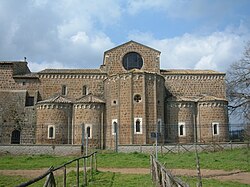Santa Maria di Falleri Monastery
| Cistercian Abbey of Santa Maria di Falleri | |
|---|---|
 former abbey church |
|
| location |
Region of Lazio Province of Viterbo |
| Coordinates: | 42 ° 18 '0 " N , 12 ° 21' 21" E |
| Serial number according to Janauschek |
189 |
| Patronage | St. Mary |
| founding year | 1143 |
| Year of dissolution / annulment |
1649 |
| Mother monastery | Saint-Sulpice monastery |
| Primary Abbey | Pontigny monastery |
|
Daughter monasteries |
|
The Monastery of Santa Maria di Falleri (Faleri) is a former Cistercian abbey in Lazio , Italy . It is the only remaining building complex in Falerii Novi in the municipality of Fabrica di Roma in the province of Viterbo .
history

Whether a Benedictine monastery had existed there since the 11th century , which had formed at the former cathedral of the abandoned Falerii Novi, is disputed. Probably around 1143, the founding convent from Saint-Sulpice monastery in the French department of Ain took possession of the monastery, which thus belonged to the filiation of the Pontigny primary abbey . However, the first reliable evidence comes from the year 1179, when Pope Alexander III. Confirmed property and rights of the Cistercians. In 1183 and 1186 two altars in the transept chapels of the church were consecrated. The church is said to have been completed in the last decade of the 12th century. In 1217 the monastery of St-Sulpice tried to break away. In 1260, Catacumbas Monastery in Rome became a subsidiary of Falleri Monastery. In 1355 or 1359 Pope Innocent IV transferred the abbey to the monastery of San Lorenzo fuori le mura for reform. In 1392 the property was transferred to the Santo Spirito Hospital in Sassia , while the church and the abbey fell into the future around 1400 . At the end of the 15th century, Cesare Borgia was Commendatabbot. In 1571 the monastery was in ruins. From 1649 the abbey belonged to the papal chamber, which in 1786 transferred it to the parish of Fabrica di Roma.
Plant and buildings
The complex, whose vaults had already collapsed, has been restored. The exam is just south of the cross-shaped, three-aisled Romanesque church with big cross-shaped pillars and columns in the nave, the first well planned vault was not executed, the transept has four chapels with semicircular, crowned by a cornice with arched frieze apses of small tuff blocks (see. Monastery Flaran in the Occitanie region ). The choir is closed by a polygonal apse with pilaster strips at the edges (cf. Monastery of San Martino al Cimino ), which is narrower than the central nave. The main portal is a cosmatic work . The west facade has a rose window.
literature
- Balduino Gustavo Bedini: Breve prospetto delle abazie cistercensi d'Italia , o. O. (Casamari), 1964, without ISBN, pp. 40-42;
- Enrico Parlato, Serena Romano: Romanesque in Rome and Latium , Echter Verlag , Würzburg 1995, pp. 299–301, ISBN 3-429-01705-X